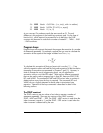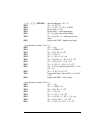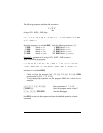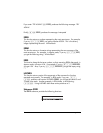
Page 21-61
Example – generate a list of numbers using a FOR…STEP construct
Type in the program:
« → xs xe dx « xe xs – dx / ABS 1. + → n « xs xe FOR x x
dx STEP n →LIST » » »
and store it in variable @GLIS2.
Θ Check out that the program call 0.5 ` 2.5 ` 0.5 ` @GLIS2
produces the list {0.5 1. 1.5 2. 2.5}.
Θ To see step-by-step operation use the program DBUG for a short list, for
example:
J1 # 1.5 # 0.5 ` Enter parameters 1 1.5 0.5
[‘] @GLIS2 ` Enter the program name in level 1
„°LL @)@RUN@ @@DBG@ Start the debugger.
Use @SST↓@ to step into the program and see the detailed operation of each
command.
The DO construct
The general structure of this command is:
DO program_statements UNTIL logical_statement END
The DO command starts an indefinite loop executing the program_statements
until the logical_statement returns FALSE (0). The logical_statement must
contain the value of an index whose value is changed in the
program_statements.
Example 1
- This program produces a counter in the upper left corner of the
screen that adds 1 in an indefinite loop until a keystroke (press any key) stops
the counter:
« 0 DO DUP 1 DISP 1 + UNTIL KEY END DROP »
Command KEY evaluates to TRUE when a keystroke occurs.
Example 2
– calculate the summation S using a DO…UNTIL…END construct


















